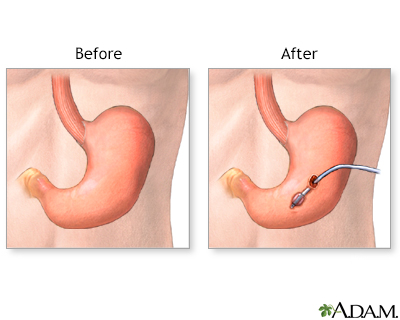Feeding tube insertion - gastrostomy
Gastrostomy tube insertion; G-tube insertion; PEG tube insertion; Stomach tube insertion; Percutaneous endoscopic gastrostomy tube insertionA gastrostomy feeding tube (G-tube) insertion is the placement of a feeding tube through the skin and the stomach wall. It goes directly into the stomach.
Description
Gastrostomy feeding tube insertion is done in part using a procedure called endoscopy. This is a way of looking inside the body using a flexible tube with a small camera on the end of it. The endoscope is inserted through the mouth and down the esophagus, which leads to the stomach.
Endoscopy
Endoscopy is a way of looking inside the body using a flexible tube that has a small camera and light on the end of it. This instrument is called an...

After the endoscopy tube is inserted into the stomach, the skin over the left side of the belly (abdomen) area is cleaned and numbed. Your surgeon makes a small surgical cut in this area. The G-tube is inserted through this cut into the stomach. The tube is small, flexible, and hollow. Your surgeon uses stitches to close the stomach around the tube.
Why the Procedure Is Performed
Gastrostomy feeding tubes are put in for different reasons. They may be needed for a short time or permanently. This procedure may be used for:
- Babies with birth defects of the mouth, esophagus, or stomach (for example, esophageal atresia or tracheal esophageal fistula)
Esophageal atresia
Esophageal atresia is a birth defect in which the esophagus does not develop properly. The esophagus is the tube that normally carries food from the...
Read Article Now Book Mark ArticleFistula
A fistula is an abnormal connection between two body parts, such as an organ or blood vessel and another structure. Fistulas are usually the result ...
 ImageRead Article Now Book Mark Article
ImageRead Article Now Book Mark Article - People who cannot swallow correctly
- People who cannot take enough food by mouth to stay healthy
- People who often breathe in food when eating
Risks
Risks for surgical or endoscopic feeding tube insertion are:
- Bleeding
- Infection
Before the Procedure
You will be given a sedative and a painkiller. In most cases, these medicines are given through a vein (IV line) in your arm. You should feel no pain and not remember the procedure.
IV
Intravenous means "within a vein. " Most often it refers to giving medicines or fluids through a needle or tube inserted into a vein. This allows th...
Read Article Now Book Mark ArticleA numbing medicine may be sprayed into your mouth to prevent the urge to cough or gag when the endoscope is inserted. A mouth guard will be inserted to protect your teeth and the endoscope.
Dentures must be removed.
After the Procedure
This is most often a simple surgery with a good outlook. Follow any self-care instructions you're given, including:
Self-care instructions
A PEG (percutaneous endoscopic gastrostomy) feeding tube insertion is the placement of a feeding tube through the skin and the stomach wall. It goes...

- How to care for the skin around the tube
- Signs and symptoms of infection
- What to do if the tube is pulled out
- Signs and symptoms of tube blockage
- How to empty the stomach through the tube
- How and what to feed through the tube
- How to hide the tube under clothing
- What normal activities can be continued
Outlook (Prognosis)
The stomach and abdomen will heal in 5 to 7 days. Moderate pain can be treated with medicine. Feedings will start slowly with clear liquids, and increase slowly.
References
Kessel D, Robertson I. Treating gastrointestinal conditions. In: Kessel D, Robertson I, eds. Interventional Radiology: A Survival Guide. 4th ed. Philadelphia, PA: Elsevier; 2017:chap 42.
Murray TE, Lee MJ. Gastrostomy and jejunostomy. In: Mauro MA, Murphy KP, Thomson KR, Venbrux AC, Morgan RA, eds. Image-Guided Interventions. 3rd ed. Philadelphia, PA: Elsevier; 2021:chap 91.
Twyman SL, Davis PW. Percutaneous endoscopic gastrostomy placement and replacement. In: Fowler GC, ed. Pfenninger and Fowler's Procedures for Primary Care. 4th ed. Philadelphia, PA: Elsevier; 2020:chap 92.
Review Date: 5/29/2024
Reviewed By: Debra G. Wechter, MD, FACS, General Surgery Practice Specializing in Breast Cancer, Virginia Mason Medical Center, Seattle, WA. Also reviewed by David C. Dugdale, MD, Medical Director, Brenda Conaway, Editorial Director, and the A.D.A.M. Editorial team.









